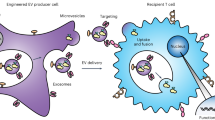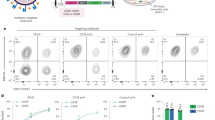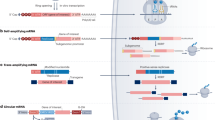Abstract
Immune cells become increasingly attractive as delivery system for immunotoxins in cancer therapy to reduce the intrinsic toxicity and severe side effects of chimeric protein toxins. In this study, we investigated the potential of human primary T cells to deliver a secreted immunotoxin through transient messenger RNA (mRNA) transfection. The chimeric protein toxin was directed toward the neovasculature of cancer cells by fusing a truncated version of Pseudomonas exotoxin A (PE38) to human vascular endothelial growth factor (VEGF) and to the single chain variable fragment (scFv) of anti-Her2/neu. Protocols for the transient transfection of human embryonic kidney cells (HEK293) as well as activated primary human T cells were established. Transient transfection with mRNA coding for the immunotoxins e23-PE38, VEGF-PE38 and its attenuated variant VEGF-PE38D yielded efficient expression and secretion. Mass spectrometry analysis endorsed that a fraction of VEGF-PE38D was properly translocated into the endoplasmic reticulum. Furthermore, cytotoxic activity of immunotoxin secreting T cells toward cancer cells was confirmed in co-culture with ovarian adenocarcinoma cells in the presence of a bispecific antibody (bsAb), highlighting the potential of primary T cells for mRNA-mediated immunotoxin delivery.
This is a preview of subscription content, access via your institution
Access options
Subscribe to this journal
Receive 12 print issues and online access
$259.00 per year
only $21.58 per issue
Buy this article
- Purchase on Springer Link
- Instant access to full article PDF
Prices may be subject to local taxes which are calculated during checkout






Similar content being viewed by others
References
Chung DS, Shin HJ, Hong YK . A new hope in immunotherapy for malignant gliomas: adoptive T cell transfer therapy. J Immunol Res 2014; 2014: 1–16.
Fesnak AD, June HJ, Bruce LL . Engineered T cells: the promise and challenges of cancer immunotherapy. Nat Rev Cancer 2016; 16: 566–581.
Restifo NP, Dudley ME, Rosenberg SA . Adoptive immunotherapy for cancer: harnessing the T cell response. Nat Rev Immunol 2012; 12: 269–281.
Kalos M, Levine BL, Porter DL, Katz S, Grupp SA, Bagg A . T cells with chimeric antigen receptors have potent antitumor effects and can establish memory in patients with advanced leukemia. Sci Transl Med 2011; 3: 1–11.
Chen SY, Yang AG, Chen JD, Kute T, King CR, Collier J et al. Potent antitumour activity of a new class of tumour-specific killer cells. Nature 1997; 385: 78–80.
Thorpe PE . Vascular targeting agents as cancer therapeutics. Clin Cancer Res 2004; 10: 415–427.
Ellis ML, Hicklin DJ . VEGF-targeted therapy: mechanisms of anti-tumor activity. Nat Rev Cancer 2008; 8: 579–591.
Robinson CJ, Stringer SE . The splice variants of vascular endothelial growth factor (VEGF) and their receptors. J Cell Sci 2001; 114: 853–865.
Kreitman RJ, Siegall CB, Chaudhary VK, FitzGerald DJ, Pastan I . Properties of chimeric toxins with two recognition domains: interleukin 6 and transforming growth factor α at different locations in Pseudomonas exotoxin. Bioconjug Chem 1992; 3: 63–68.
Becker N, Benhar I . Antibody-based immunotoxins for the treatment of cancer. Antibodies 2012; 1: 39–69.
Simon N, FitzGerald D . Immunotoxin therapies for the treatment of epidermal growth factor receptor-dependent cancers. Toxins 2016; 8: 137.
Kreitman RJ, Tallman MS, Robak T, Coutre S, Wilson WH, Stetler-Stevenson M . Phase I trial of anti-CD22 recombinant immunotoxin moxetumomab pasudotox (CAT-8015 or HA22) in patients with hairy cell leukemia. J Clin Oncol 2012; 30: 1822–1828.
Hu CC, Ke YQ, Sun XL, Jiang XD, Xu RX, Lv J . Human mesenchymal stem cells-like cells as cellular vehicles for delivery of immunotoxin in vitro. Biotechnol Lett 2009; 31: 181–189.
Douglas CM, Collier RJ . Exotoxin A of Pseudomonas aeruginosa: substitution of glutamic acid 553 with aspartic acid drastically reduces toxicity and enzymatic activity. J Bacteriol 1987; 169: 4967–4971.
Guzmán-Hernández ML, Potter G, Egervári K, Kiss JZ, Balla T . Secretion of VEGF-165 has unique characteristics, including shedding from the plasma membrane. Mol Biol Cell 2014; 25: 1061–1072.
Hackett PB, Largaespada DA, Switzer KC, Cooper LJ . Evaluating risks of insertional mutagenesis by DNA transposons in gene therapy. Transl Res 2013; 161: 265–283.
Holtkamp S, Kreiter S, Selmi A, Simon P, Koslowski M, Huber C et al. Modification of antigen-encoding RNA increases stability, translational efficacy, and T-cell stimulatory capacity of dendritic cells. Blood 2006; 108: 4009–4017.
Ejeskär K, Fransson S, Zaibak F, Ioannou PA . Method for efficient transfection of in vitro-transcribed mRNA into SK-N-AS and HEK293 cells: difference in the toxicity of nuclear EGFP compared to cytoplasmic EGFP. Int J Mol Med 2006; 17: 1011–1016.
Schaft N, Dörrie J, Müller I, Beck V, Baumann S, Schunder T . A new way to generate cytolytic tumor-specific T cells: electroporation of RNA coding for a T cell receptor into T lymphocytes. Cancer Immunol Immunother 2006; 55: 1132–1141.
Youniss FM, Sundaresan G, Graham LJ, Wang L, Bery CR, Dewkar GK et al. Near-infrared imaging of adoptive immune cell therapy in breast cancer model using cell membrane labeling. PLoS One 2014; 9: e109162.
Jin N, Chen W, Blazar BR, Ramakrishnan S, Vallera DA . Gene therapy of murine solid tumors with T cells transduced with a retroviral vascular endothelial growth factor-immunotoxin target gene. Hum Gene Ther 2002; 13: 497–508.
Vallera DA, Jin N, Baldrica JM, Panoskaltsis-Mortari A, Chen SY, Blazar BR . Retroviral immunotoxin gene therapy of acute myelogenous leukemia in mice using cytotoxic T cells transduced with an interleukin 4/diphtheria toxin gene. Cancer Res 2000; 60: 976–984.
Lukac M, Collier RJ . Restoration of enzymic activity and cytotoxicity of mutant, E553C, Pseudomonas aeruginosa exotoxin A by reaction with iodoacetic acid. J Biol Chem 1988; 263: 6146–6149.
Han XY, Galloway DR . Active site mutations of Pseudomonas aeruginosa exotoxin A analysis of the his residue. J Biol Chem 1995; 270: 679–684.
Pastan I, Hassan R, FitzGerald DJ, Kreitman RJ . Immunotoxin treatment of cancer. Annu Rev Med 2007; 58: 221–237.
Batra JK, Kasprzyk PG, Bird RE, Pastan I, Richter King C . Recombinant anti-erbB2 immunotoxins containing Pseudomonas exotoxin. Proc Natl Acad Sci USA 1992; 89: 5867–5871.
Pastan I, Benhar I, Padlan EA, Jung SH, Lee B. Humanized B3 antibody fragments, fusion proteins, and uses thereof, 1999. Patent US5889157A..
Schägger H, von Jagow G . Tricine-sodium dodecyl sulfate-polyacrylamide gel electrophoresis for the separation of proteins in the range from 1 to 100 kDa. Anal Biochem 1987; 166: 368–379.
Strauß G, Gückel B, Wallwiener D, Moldenhauer G . Without prior stimulation, tumor-associated lymphocytes from malignant effusions lyse autologous tumor cells in the presence of bispecific antibody HEA125xOKT3. Clin Cancer Res 1999; 5: 171–180.
Candiano G, Bruschi M, Musante L, Santucci L, Ghiggeri GM, Carnemolla B et al. Blue silver: a very sensitive colloidal Coomassie G‐250 staining for proteome analysis. Electrophoresis 2004; 25: 1327–1333.
Shevchenko A, Wilm M, Vorm O, Mann M . Mass spectrometric sequencing of proteins from silver-stained polyacrylamide gels. Anal Chem 1996; 68: 850–858.
Baker PR, Clauser KR. Available at: http://prospector.ucsf.edu.
Acknowledgements
We kindly thank Dr Niels Schaft (Uniklinik Erlangen) for providing plasmids pGEM-4Z/EGFP and pGEM-4Z, Dr Gerhard Moldenhauer (German Cancer Research Center) for providing the bsAb HEA125xOKT3, and KIST Europe for basic funding and financial support.
Author information
Authors and Affiliations
Corresponding authors
Ethics declarations
Competing interests
The authors declare no conflict of interest.
Rights and permissions
About this article
Cite this article
Eggers, R., Philippi, A., Altmeyer, M. et al. Primary T cells for mRNA-mediated immunotoxin delivery. Gene Ther 25, 47–53 (2018). https://doi.org/10.1038/gt.2017.87
Received:
Revised:
Accepted:
Published:
Issue Date:
DOI: https://doi.org/10.1038/gt.2017.87



